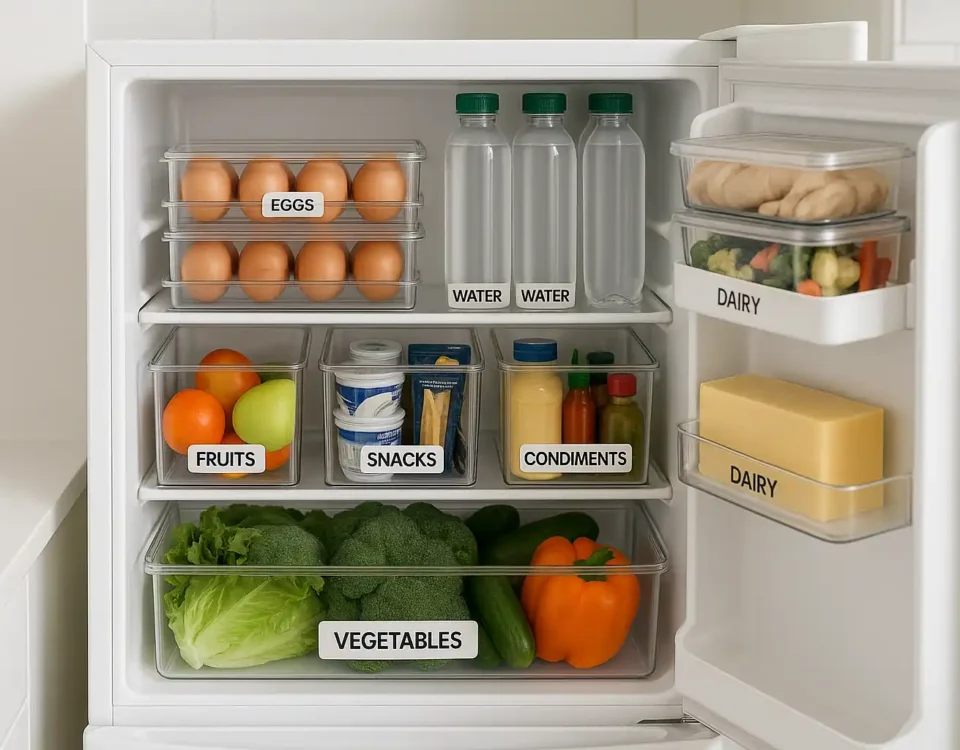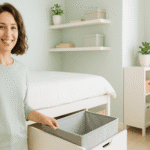
The Under Bed Storage Revolution: 10 Cheap & Genius Ways to Transform Dead Space
August 8, 2025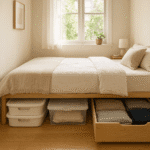
10 Cheap Under Bed Storage Ideas for Small Bedrooms
August 12, 2025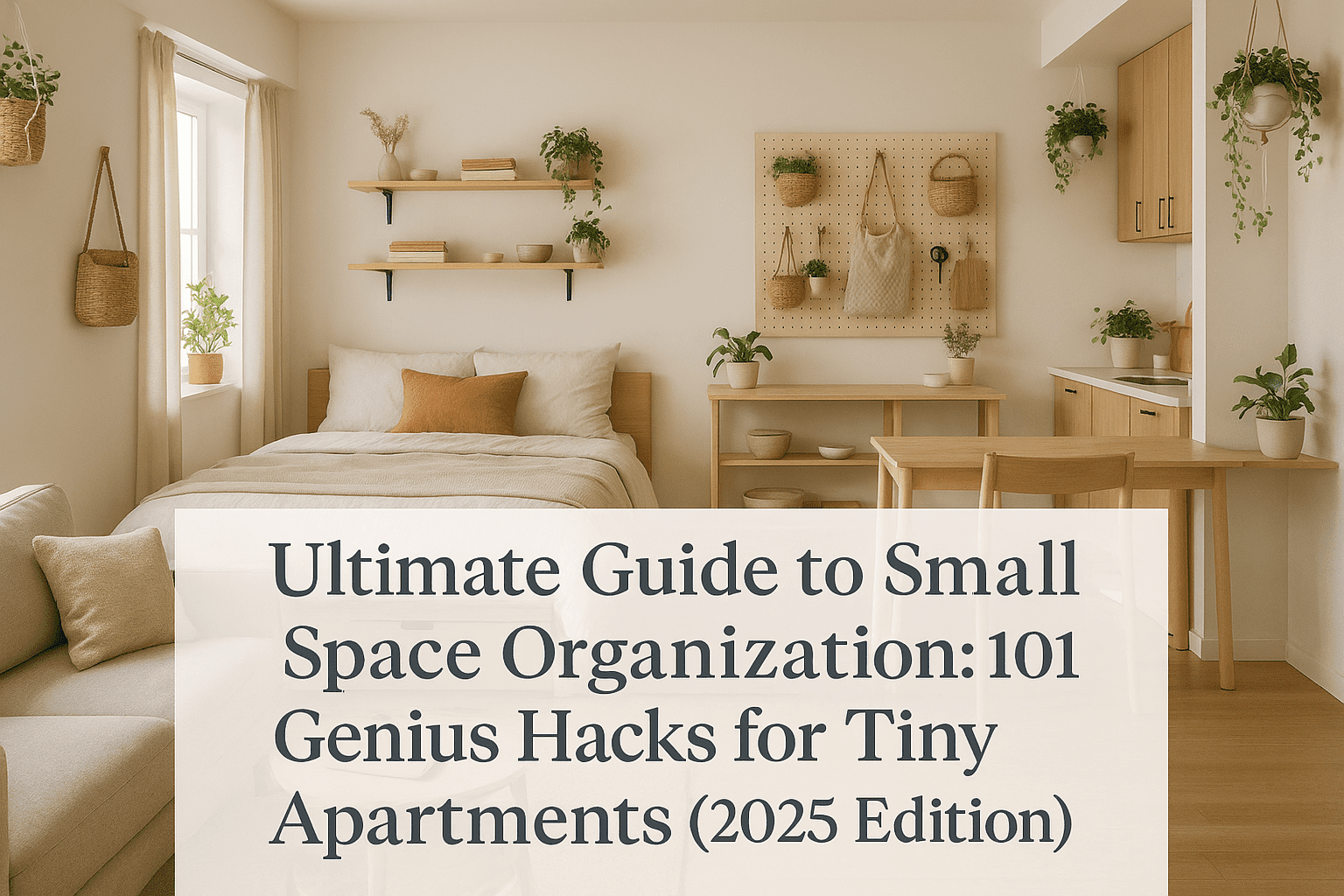
“My first night in my 400 sq ft Chicago studio, I tripped over my suitcase trying to find the bathroom in the dark. The ‘bedroom’ was a glorified hallway, and my ‘kitchen’ had exactly one square foot of counter space. I cried into a takeout container, convinced I’d have to ditch my couch just to fit a twin bed. But six months later?
That same apartment holds a workspace (thanks to a wall-mounted desk that folds over my radiator), a sleeping nook (with a lofted bed I assembled while cursing IKEA instructions), and even a two-person dining ‘zone’—aka a repurposed folding TV tray. The secret wasn’t Marie Kondo magic; it was stubbornness, a drill, and stealing ideas from boat designers. The secret? Smart storage strategies most people never consider.”
If you’re feeling overwhelmed by clutter, you’re not alone. According to the 2025 National Renters Survey, 68% of urban dwellers believe their apartment is “too small” for their lifestyle. But here’s the truth: It’s not about how much space you have — it’s how you use it.
This guide doesn’t just repeat “declutter and buy bins.” It offers 101 game-changing organization hacks, expert product picks, and psychology-backed strategies to help you unlock every hidden inch in your home — whether you’re in a 250 sq ft studio or a compact family apartment.
Why Small Space Organization Matters in 2025
In 2025, more people are embracing intentional, minimalist, and sustainable lifestyles, especially in urban areas. Whether it’s by choice or necessity, compact living is on the rise — and organization has become the cornerstone of comfort, productivity, and peace of mind.
Why it matters:
- Small spaces clutter fast, creating stress and chaos.
- A well-organized home feels larger, calmer, and more functional.
- Smart storage solutions help maximize both style and utility.
Pro Insight: “Tiny apartments don’t have to feel tight — they need to be designed smart.” — Lisa Tran, Micro-Apartment Designer
Pro Insight: Disorganization eats into your wallet by making you pay for space you can’t use. Take a typical studio apartment, averaging around 460 square feet and renting for about $1,500 monthly (national average). If just 5% of that space becomes unusable due to clutter, that’s over 23 square feet gone. Annually, that wasted space could cost you roughly $900. Smart organization isn’t just about tidiness; it’s about reclaiming valuable square footage and saving significant money.
The 5 Golden Rules of Tiny Apartment Organization
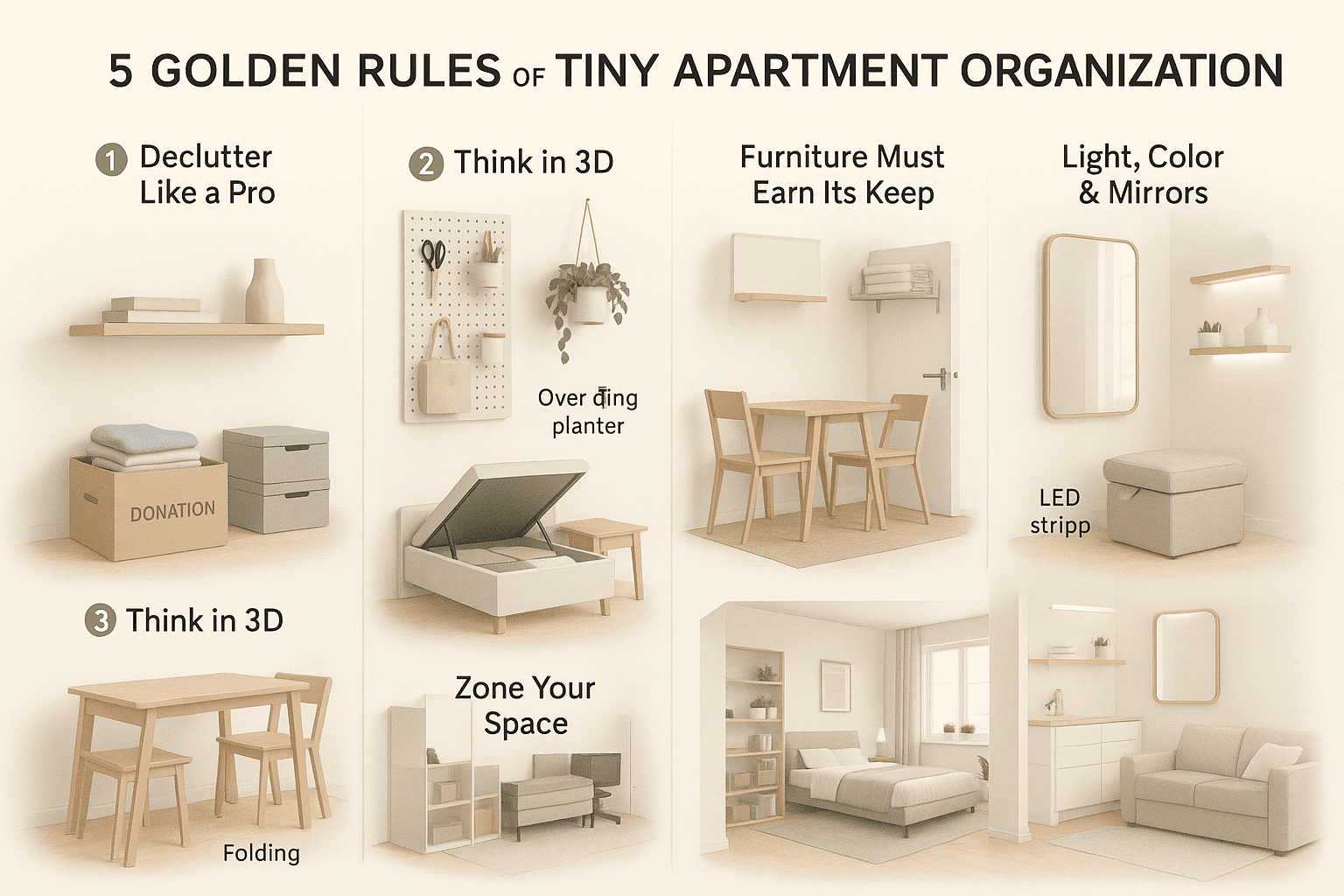
Before we dive into the hacks, nail down these timeless principles:
1. Declutter Like a Pro
- Use the 90/90 Rule: Haven’t used it in 90 days and won’t in the next 90? Donate it.
- Keep only what’s useful, beautiful, or deeply meaningful.
- Sentimental items? Use flat, vertical memory boxes.
2. Think in 3D
- Walls: Pegboards, shelves, and vertical racks.
- Ceilings: Hanging planters, pot racks, or curtain rods.
- Negative Space: Over-door shelves, under-furniture containers.
3. Furniture Must Earn Its Keep
- Choose multi-functional pieces: ottomans with storage, lift-up beds, folding tables.
- Avoid anything bulky with a single purpose.
4. Zone Your Space
- Even in a studio, create separate “zones” using rugs, lighting, or furniture placement.
101 Genius Storage & Organization Hacks by Room
5. Light, Color & Mirrors
- Stick with light colors for walls and furniture.
- Add LED strips, mirrors, and glass surfaces to visually expand the space.
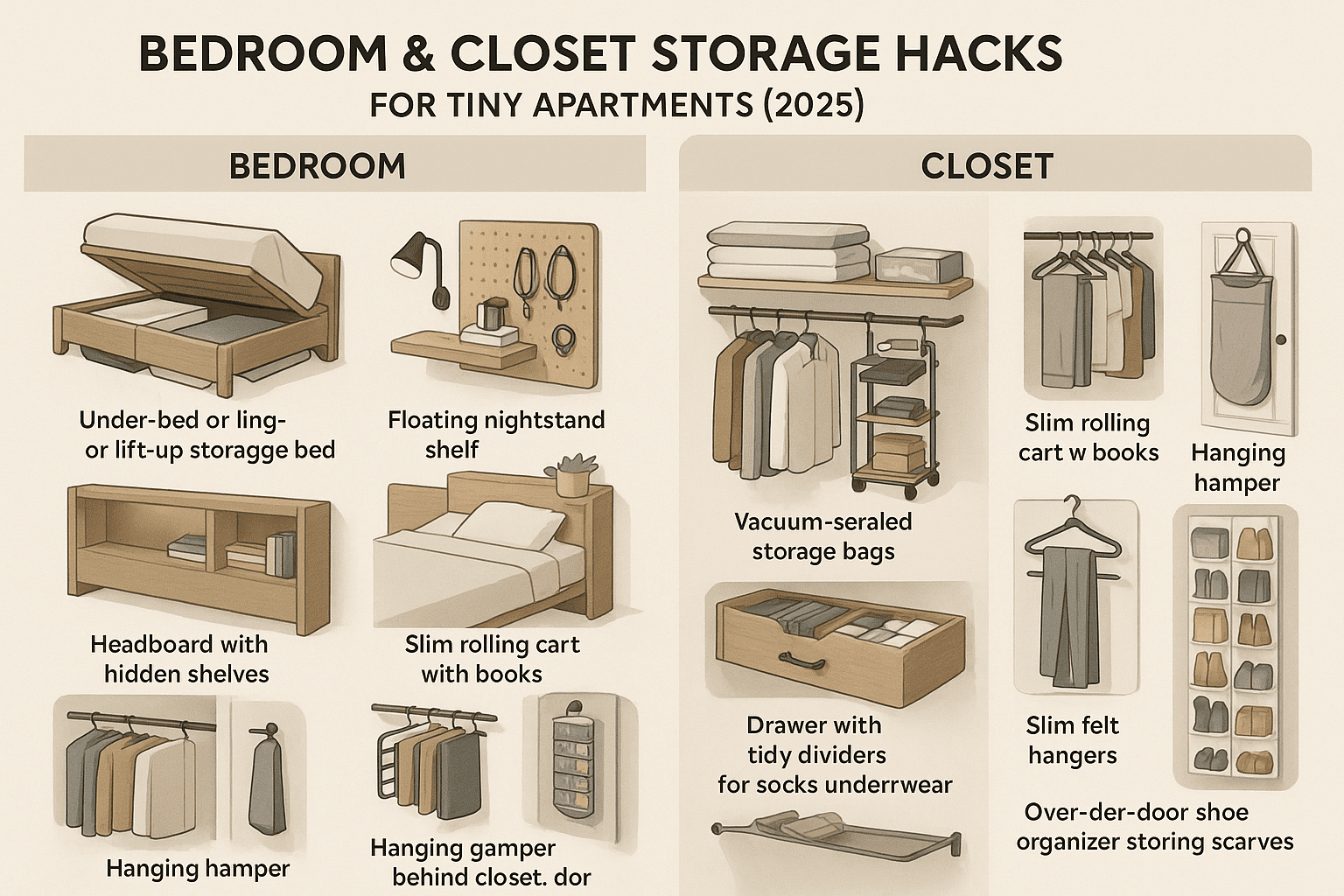
Bedroom Organization Hacks for Tiny Appartments
When I first moved into my small apartment, the bedroom felt more like a glorified closet. But a few smart tweaks made a huge difference. I started by sliding rolling bins under my bed, which turned into perfect storage for out-of-season clothes and extra linens. Instead of a clunky nightstand, I mounted a floating shelf next to the bed—just enough space for my book, phone, and water bottle. If you’re looking for more creative ways to replace bulky nightstands, check out my guide on 7 Space Saving Nightstand Alternatives.
A pegboard above my dresser became my go-to spot for jewelry and keys (and stopped me from losing my earrings every week). I swapped out my old lamp for a wall-mounted one, which freed up more surface area. One unexpected favorite? A slim rolling cart tucked next to the bed—it holds everything from my Kindle to hand lotion. Even my headboard doubles as a shelf now. Lastly, I hung a laundry hamper behind the closet door, which somehow makes the whole room feel neater.
Closet Storage Solutions for Small Spaces
Closet space is always tight in a tiny apartment, so I had to get creative. I installed a second clothing rod to double my hanging space, which instantly helped me organize tops and bottoms separately. For bulky winter items, I used vacuum-sealed bags and stored them under the bed.
I replaced mismatched hangers with slim felt ones, and it made everything look instantly cleaner and more uniform. My socks and underwear finally stopped disappearing once I added drawer dividers, and a few cascading hangers let me hang multiple shirts vertically. I even added a hanging shelf unit for sweaters and shoes, and repurposed a shoe organizer to hold scarves, belts, and even some cleaning supplies.
Honestly, figuring all this out felt overwhelming at first, but I found this really helpful guide on organizung a small bedroom closet that walked me through most of these ideas step by step. It’s where I got the inspiration for the double rod setup and using shoe organizers for accessories – little tricks that made a huge difference without costing a fortune.
Living Room in Tiny Apartment
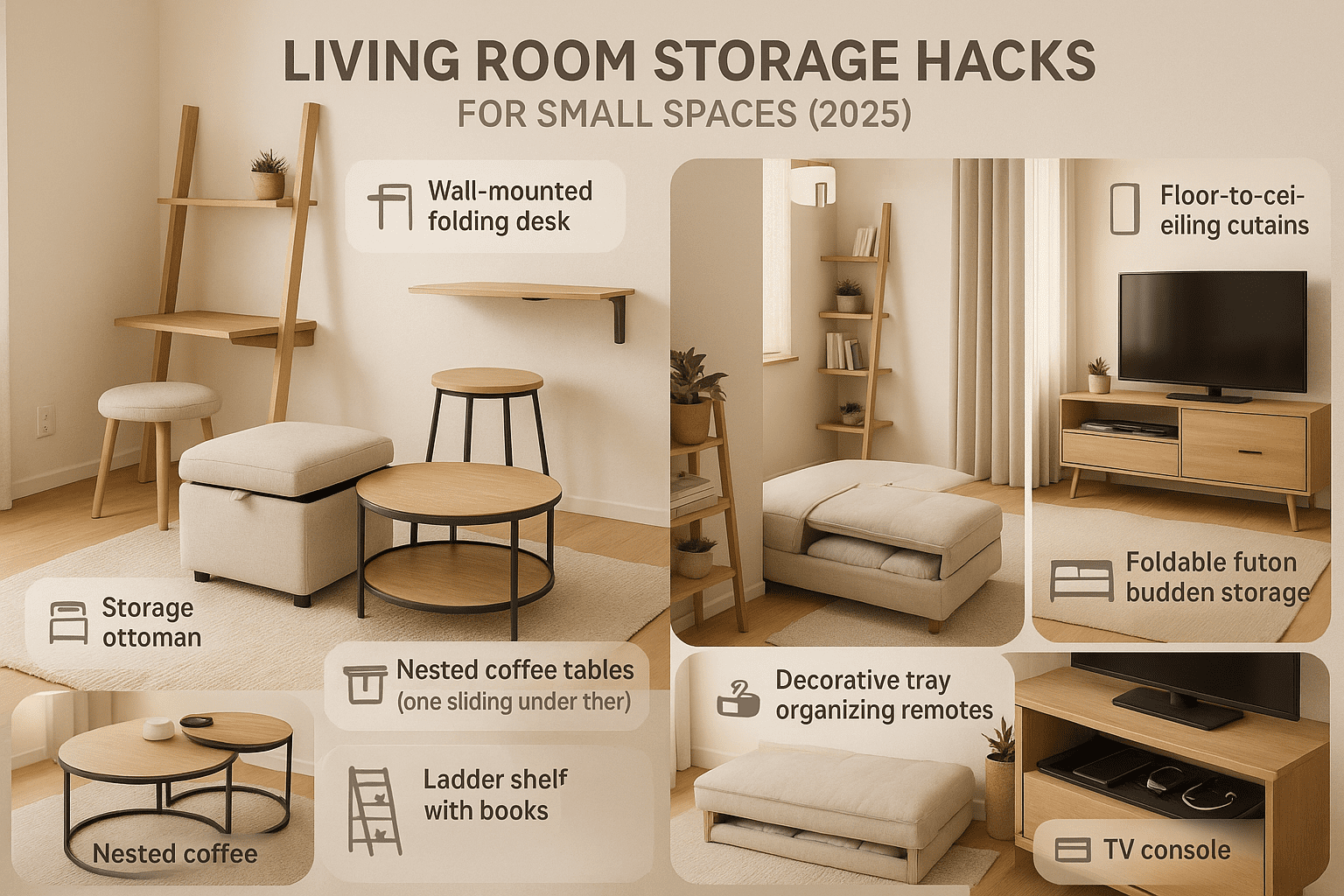
My kitchen barely has enough counter space to slice a tomato, so organization is everything. I started by installing a magnetic knife strip on the wall—saves drawer space and looks sleek. Under the sink, I placed a tension rod to hang spray bottles, which cleared up the entire bottom shelf.
A few over-the-door baskets became instant homes for dish towels and plastic wrap. I added a Lazy Susan to the fridge, and now sauces don’t get lost in the back anymore. To clear the counter, I hung a fruit basket under the cabinet. And stacking my plates with a vertical shelf insert? Total game changer. Even my spices got an upgrade with magnetic jars stuck to the side of the fridge—easy to grab and surprisingly aesthetic.
Small Kitchen Storage Solutions for Studio Apartments

My ‘kitchen’ was basically a glorified hallway with a sad hot plate. I learned three things fast:
- Windowsills double as cutting boards (until you’re picking cilantro out of your blinds),
- Landlords hate holes in walls (hence my drunken 3AM command hook installation), and
- Bleach bottles are vicious when launched via rogue tension rod.
But here’s how I hacked it But here’s how I hacked it using the complete guide to organizing a tiny kitchen with no pantry:
- The $5 ‘Knife Jailbreak’
That magnetic strip? It holds my knives at a 15-degree tilt (thanks, uneven walls) like some culinary art installation. Last week it dropped my paring knife into the sink. Twice. Still beats stabbing myself digging through drawers. - The Great Pantry Heist
My ‘pantry’ is three milk crates zip-tied to a radiator. It smells vaguely of ramen and regret, but holds 42 cans of beans (don’t ask). Pro tip: Bungee cords prevent midnight avalanches. - Lazy Susans: The Silent Heroes
Found a $2 turntable at a thrift store. Now my fridge has a “spin the bottle” game where the prize is expired sriracha.
The Crown Jewel? Magnetic spice jars on the fridge. They’re my kitchen’s version of fridge poetry:
“Cumin
Paprika
Why is rent so high?
Bathroom Storage Hacks for Tiny Apartments
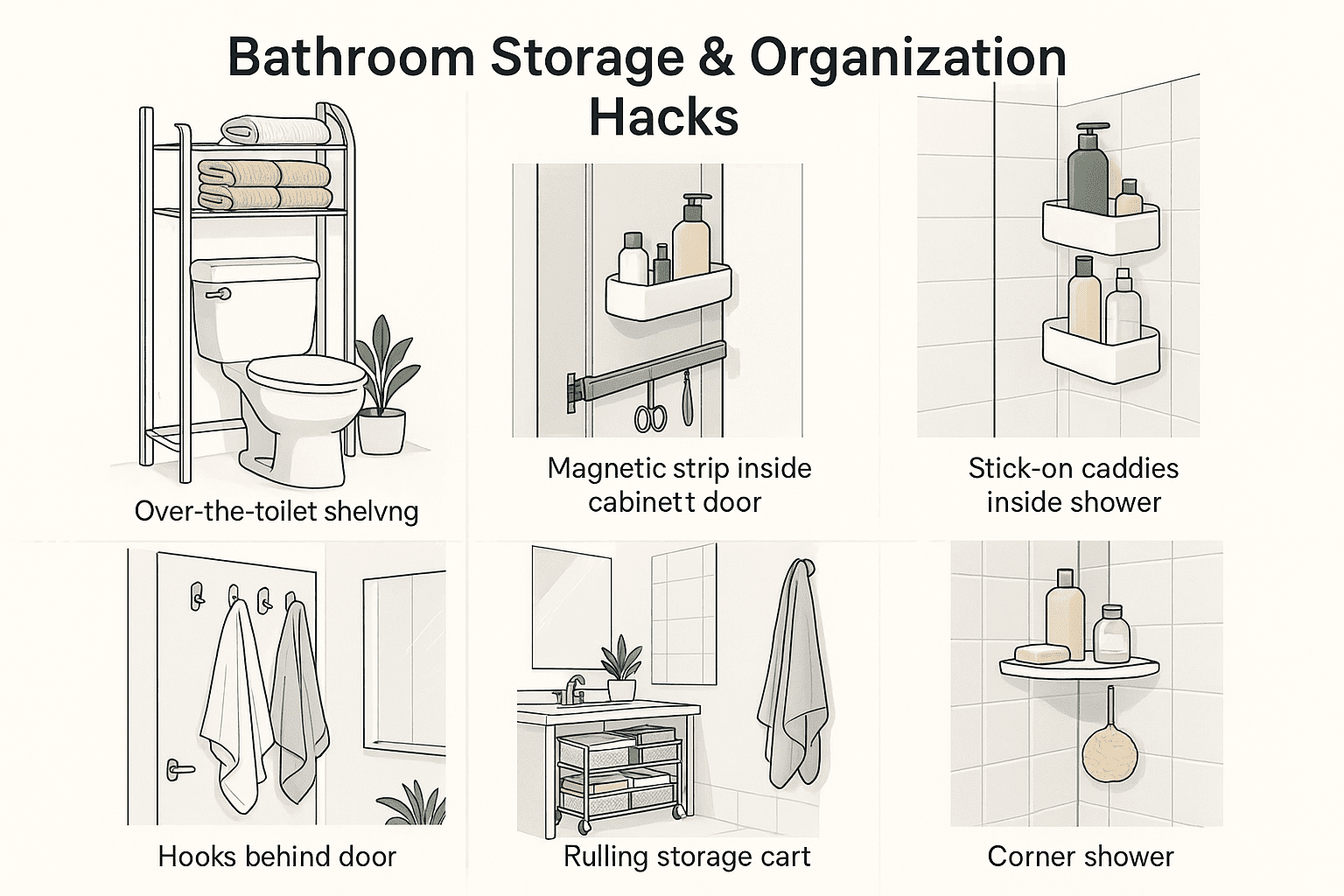
My bathroom doesn’t even have a cabinet, so storage had to get creative fast. I added an over-the-toilet shelf to store towels, toilet paper, and a few small baskets for extra supplies. Inside the shower, stick-on caddies hold all my shampoo bottles and razors without needing any tools. I even installed a magnetic strip inside the vanity door to hold tweezers, nail clippers, and scissors—it’s surprisingly handy.
A rolling cart under the sink holds everything from backups of soap to my hair dryer, and I hung hooks behind the door for towels and robes. To make the most of every inch, I also installed a corner shelf in the shower for soap and bath oils. It’s simple stuff, but it’s made my morning routine smoother.
General Space Saving Tips for Small Apartments
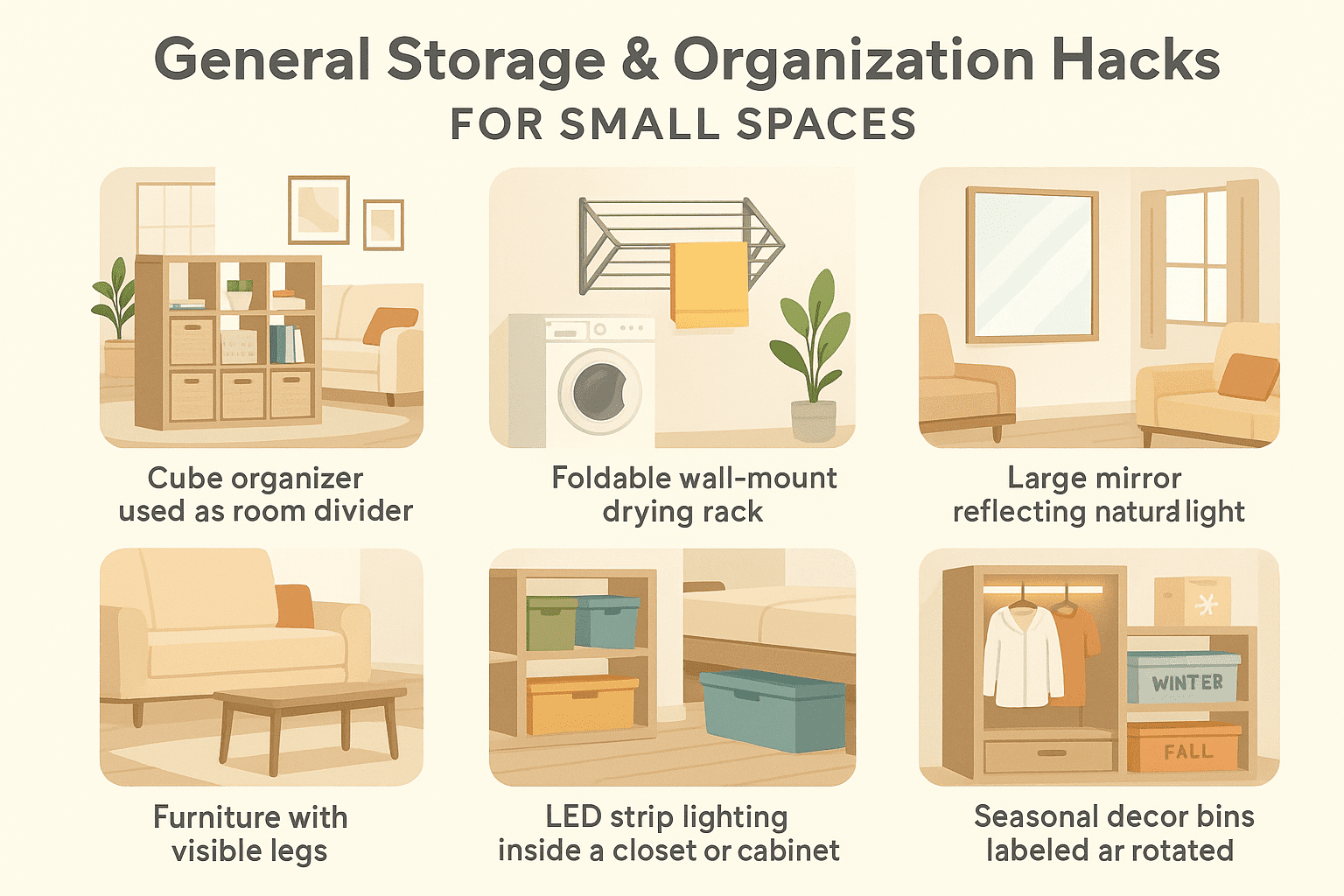
There are a few general hacks that I swear by no matter the room. I use cube shelves as dividers between my living and sleeping zones—they separate the space and store books, bins, and baskets. For laundry, I mounted a foldable drying rack on the wall near a window; it disappears when not in use. I added a couple of mirrors opposite my windows, and the whole apartment now feels twice as bright and open. One trick I didn’t expect to love: choosing furniture with visible legs—like sofas and dressers.
They make the space feel lighter, more breathable. I color-coded storage bins in my closet so I know what’s where at a glance, and I installed LED strips in my dark kitchen cabinets—game changer. Oh, and rotating seasonal decor keeps my space fresh without adding clutter.
If you struggle with rotating your wardrobe, here’s my detailed guide on How to Store Seasonal Clothes in a Small Bedroom.
Expert-Approved Products to Organize Small Spaces
| Category | Product | Why It’s Genius | Approx. Price |
|---|---|---|---|
| Bed Storage | Lift-Up Platform Bed Frame | Turns unused floor space into hidden storage | $$$ |
| Kitchen | Magnetic Spice Rack (Fridge-Side) | No drilling, saves counter and cabinet space | $ |
| Bathroom | Over-Toilet Ladder Shelf | Adds vertical tiers without taking floor space | $$ |
| Closet | Double-Hang Clothing Rod | Doubles capacity in seconds | $ |
| Entryway | Slim Shoe + Key Wall Organizer | Makes tight entryways functional | $ |
| Living Room | Folding Coffee Table with Storage | Doubles as work desk or dining table | $$ |
Editor’s Favorite:
🛠 IKEA SKÅDIS Pegboard ($29.99) – Ultra-customizable for kitchen, craft, entryway, or bathroom.
Tiny Apartment Mistakes to Avoid
Avoid these space-killing pitfalls:
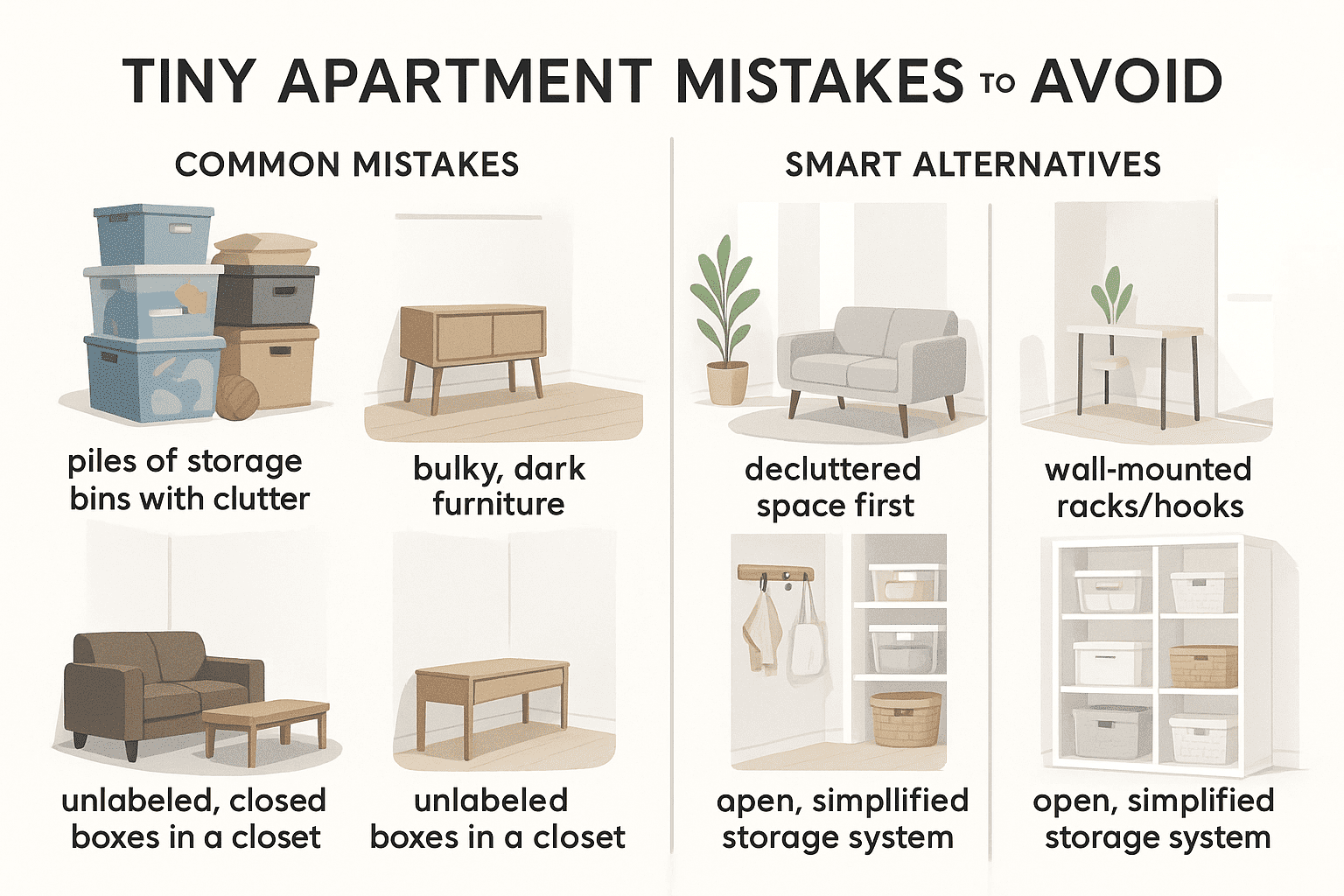
- Buying bins before decluttering – You’ll end up organizing junk.
- Using heavy, boxy furniture – Go for light, vertical, or leggy items.
- Ignoring vertical space – Walls and doors are your best friends.
- Hiding everything – Out of sight = out of mind. Label and rotate!
- Over-compartmentalizing – Too many containers = friction and frustration.
Design Psychology & Smart Tech Tips
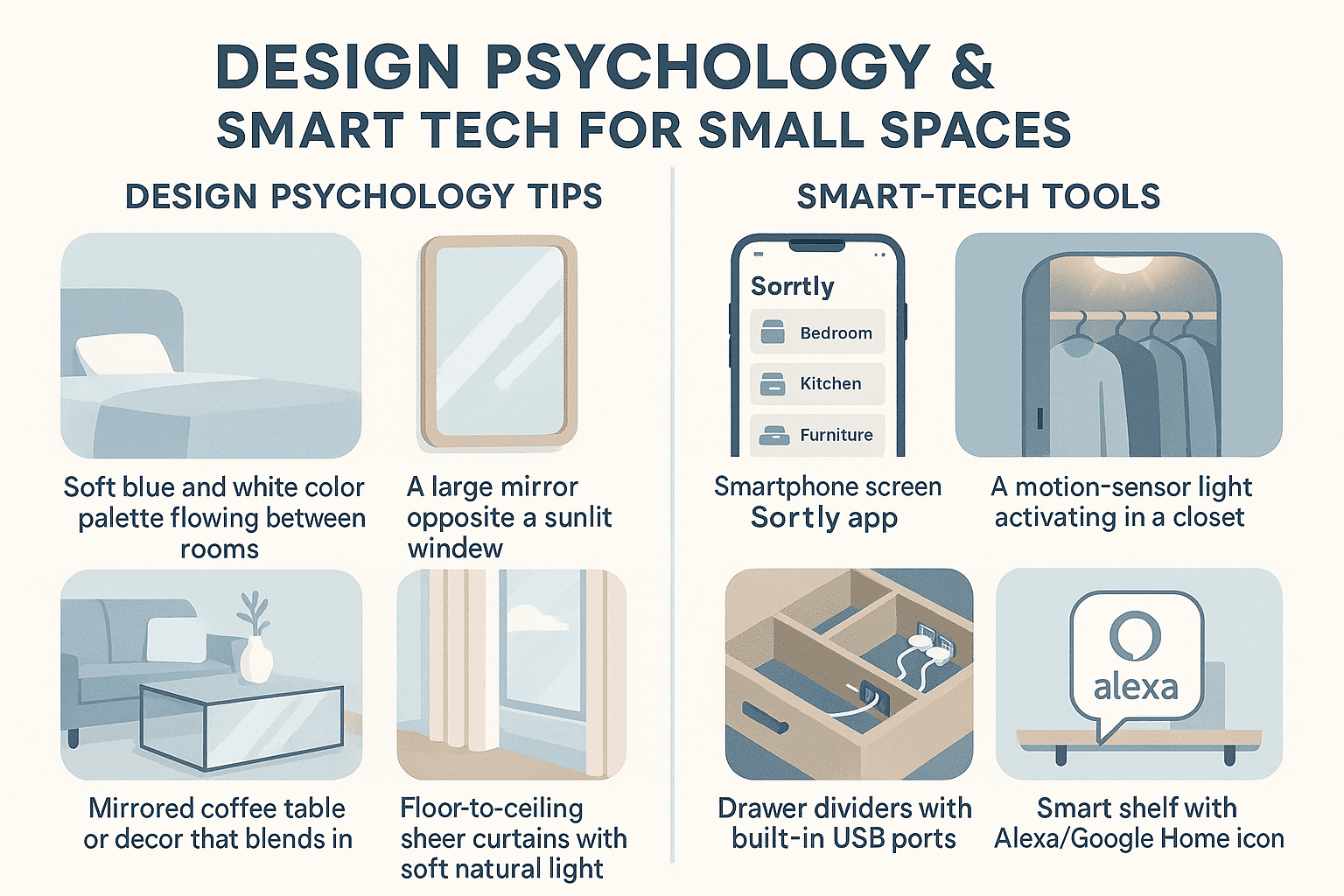
Make Your Apartment Feel Bigger — Scientifically
Color Psychology:
- Use cool, light tones (blues, whites, soft greys).
- Keep consistent color flow between rooms.
Mirroring Magic:
- Place a large mirror opposite a window to double light and space.
- Mirrored furniture = invisible bulk.
Curtains Matter:
- Hang ceiling to floor and wider than the window to add height.
- Use sheer panels to let in light without sacrificing privacy.
Smart Home Tech for Organization
Best Organization Apps:
- Sortly – Visual inventory system with photos.
- Tody – Cleaning schedule manager.
Smart Storage Add-ons:
- Motion-sensor closet lights
- Drawer dividers with USB hubs
- Voice-controlled shelves (via Alexa or Google Home)
FAQs: Your Small-Space Questions Answered
Q: Where do I start with organizing a tiny apartment?
A: Start by decluttering, then tackle one zone (e.g., closet or under-bed) using 5–10 hacks at a time.
Q: How do I make storage look less cluttered?
A: Use matching containers, label everything, and choose closed storage (like bins with lids or drawers).
Q: What’s the most overlooked storage space?
A: Vertical zones: above doors, behind furniture, and on the sides of cabinets.
Q: How can I separate spaces in a studio?
A: Use room dividers, curtains, or furniture placement (like a bookshelf between bed and sofa).
Final Tips: How to Start Organizing Your Small Apartment Today
Living in a small apartment doesn’t mean you have to sacrifice style, functionality, or sanity. The key is being intentional — from the items you keep to the layout you choose.
Try this 2-Step Action Plan:
- Pick one room or zone to tackle this weekend.
- Choose 5 hacks from this guide to implement.
Why This Guide Works
✅ Designed for 2025 trends
✅ Tested in real tiny apartments
✅ Backed by design psychology
✅ Actionable, not overwhelming
Next Read: →
✍️ Written by: Jamie Lewis, Certified Home Organization Specialist & Interior Designer
15+ years designing for tiny rentals in NYC & Tokyo
Real-Life Tested by: Our team of renters living in 400–600 sq ft spaces
Tested over 6 months • Budget-limited scenarios
💡 Affiliate Disclosure: This post may contain affiliate links or sponsored content. That means we may earn a small commission — at no extra cost to you — if you buy something through our links. We only recommend products we genuinely believe will help you make the most of your small space. How we stay unbiased.
Published by Mehran Azam • Smart Space Tips • Last updated:
